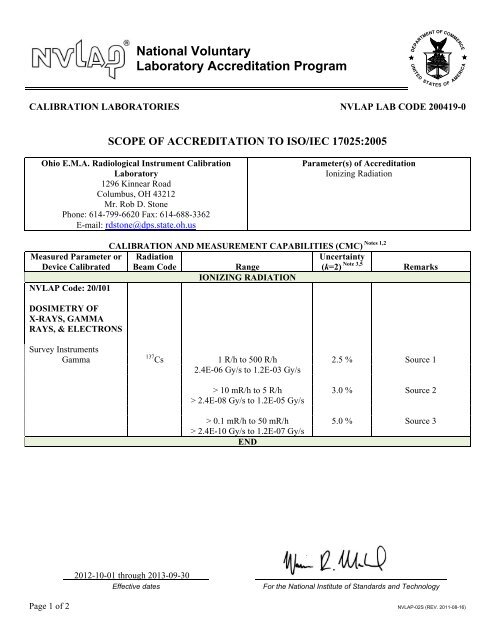Ohio E.M.A. Radiological Instrument Calibration Laboratory
Ohio E.M.A. Radiological Instrument Calibration Laboratory
Ohio E.M.A. Radiological Instrument Calibration Laboratory
You also want an ePaper? Increase the reach of your titles
YUMPU automatically turns print PDFs into web optimized ePapers that Google loves.
National Voluntary<br />
<strong>Laboratory</strong> Accreditation Program<br />
CALIBRATION LABORATORIES NVLAP LAB CODE 200419-0<br />
SCOPE OF ACCREDITATION TO ISO/IEC 17025:2005<br />
<strong>Ohio</strong> E.M.A. <strong>Radiological</strong> <strong>Instrument</strong> <strong>Calibration</strong><br />
<strong>Laboratory</strong><br />
1296 Kinnear Road<br />
Columbus, OH 43212<br />
Mr. Rob D. Stone<br />
Phone: 614-799-6620 Fax: 614-688-3362<br />
E-mail: rdstone@dps.state.oh.us<br />
Measured Parameter or<br />
Device Calibrated<br />
NVLAP Code: 20/I01<br />
DOSIMETRY OF<br />
X-RAYS, GAMMA<br />
RAYS, & ELECTRONS<br />
Survey <strong>Instrument</strong>s<br />
Gamma<br />
Parameter(s) of Accreditation<br />
Ionizing Radiation<br />
Notes 1,2<br />
CALIBRATION AND MEASUREMENT CAPABILITIES (CMC)<br />
Radiation<br />
Beam Code Range<br />
IONIZING RADIATION<br />
Uncertainty<br />
(k=2) Note 3,5 Remarks<br />
137 Cs 1 R/h to 500 R/h 2.5 % Source 1<br />
2.4E-06 Gy/s to 1.2E-03 Gy/s<br />
> 10 mR/h to 5 R/h 3.0 % Source 2<br />
> 2.4E-08 Gy/s to 1.2E-05 Gy/s<br />
> 0.1 mR/h to 50 mR/h 5.0 % Source 3<br />
> 2.4E-10 Gy/s to 1.2E-07 Gy/s<br />
END<br />
2012-10-01 through 2013-09-30<br />
Effective dates For the National Institute of Standards and Technology<br />
Page 1 of 2 NVLAP-02S (REV. 2011-08-16)
National Voluntary<br />
<strong>Laboratory</strong> Accreditation Program<br />
CALIBRATION LABORATORIES NVLAP LAB CODE 200419-0<br />
Notes<br />
Note 1: A <strong>Calibration</strong> and Measurement Capability (CMC) is a description of the best result of a calibration or measurement (result<br />
with the smallest uncertainty of measurement) that is available to the laboratory’s customers under normal conditions, when<br />
performing more or less routine calibrations of nearly ideal measurement standards or instruments. The CMC is described in the<br />
laboratory’s scope of accreditation by: the measurement parameter/device being calibrated, the measurement range, the uncertainty<br />
associated with that range (see note 3), and remarks on additional parameters, if applicable.<br />
Note 2: <strong>Calibration</strong> and Measurement Capabilities are traceable to the national measurement standards of the U.S. or to the national<br />
measurement standards of other countries and are thus traceable to the internationally accepted representation of the appropriate SI<br />
(Système International) unit.<br />
Note 3: The uncertainty associated with a measurement in a CMC is an expanded uncertainty using a coverage factor, k = 2, with a<br />
level of confidence of approximately 95 %. Units for the measurand and its uncertainty are to match. Exceptions to this occur when<br />
marketplace practice employs mixed units, such as when the artifact to be measured is labeled in non-SI units and the uncertainty is<br />
given in SI units (Example: 5 lb weight with uncertainty given in mg).<br />
Note 3a: The uncertainty of a specific calibration by the laboratory may be greater than the uncertainty in the CMC due to the<br />
condition and behavior of the customer's device and specific circumstances of the calibration. The uncertainties quoted do not<br />
include possible effects on the calibrated device of transportation, long term stability, or intended use.<br />
Note 3b: As the CMC represents the best measurement results achievable under normal conditions, the accredited calibration<br />
laboratory shall not report smaller uncertainty of measurement than that given in a CMC for calibrations or measurements<br />
covered by that CMC.<br />
Note 3c: As described in Note 1, CMCs cover calibrations and measurements that are available to the laboratory’s customers<br />
under normal conditions. However, the laboratory may have the capability to offer special tests, employing special conditions,<br />
which yield calibration or measurement results with lower uncertainties. Such special tests are not covered by the CMCs and are<br />
outside the laboratory’s scope of accreditation. In this case, NVLAP requirements for the labeling, on calibration reports, of<br />
results outside the laboratory’s scope of accreditation apply. These requirements are set out in Annex A.1.h. of NIST Handbook<br />
150, Procedures and General Requirements.<br />
Note 4: Uncertainties associated with field service calibration may be greater as they incorporate on-site environmental contributions,<br />
transportation effects, or other factors that affect the measurements. (This note applies only if marked in the body of the scope.)<br />
Note 5: Values listed with percent (%) are percent of reading or generated value unless otherwise noted.<br />
Note 6: NVLAP accreditation is the formal recognition of specific calibration capabilities. Neither NVLAP nor NIST guarantee the<br />
accuracy of individual calibrations made by accredited laboratories.<br />
Note 7: See NIST Handbook 150 for further explanation of these notes.<br />
2012-10-01 through 2013-09-30<br />
Effective dates For the National Institute of Standards and Technology<br />
Page 2 of 2 NVLAP-02S (REV. 2011-08-16)



